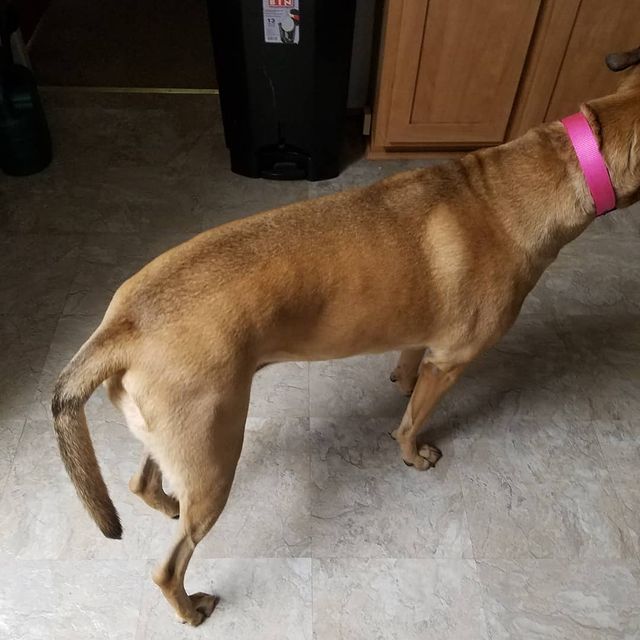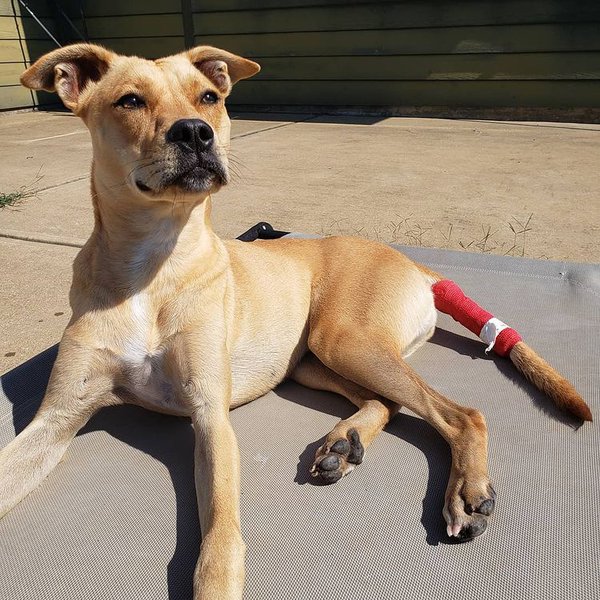Tail wagging among dogs is a common sight, and this is why it is quite worrying and problematic when a dog suddenly stops or is unable to wag its tail. However, many dog owners often wonder if it is possible for a dog to break and stop wagging its tail. So, can dogs break their tails?
Yes, dogs can suffer from a broken tail. A broken tail is a medical condition that causes severe pain to the affected pooch and impairs the pooch’s ability to communicate with other dogs and humans effectively. Treatment of the broken tail is still possible, depending on the severity of the condition.
That said, the tail is a vital part of the canine body that is essential for canine balance and communication; Hence, injuries to the tail should be, as a matter of urgency, given prompt and proper medical attention. The various causes of dog tail breaks, their degrees of severity, as well as the common treatment methods for canine tail dislocations, are all outlined in this article. However, before we go into all that, let’s see why it is possible for dogs to break their tails.
Can Dogs Break Their Tails?

Yes, the canine tail contains bones that can be broken or dislocated when subjected to excessive physical force.
A dog’s tail is the most posterior appendage of the pooch’s body, which is usually located at the end of the dog’s vertebral column and also extends beyond the Fido’s trunk. It is also important to note that the canine tail is an extension of the pooch’s spine, which is why damage to this part of a dog’s body is quite worrying.
The canine tail contains bones and muscles which typically work together to ensure smooth motion and counterbalancing when carrying out complicated movements, as well as being a key part of the dog’s communication. Muscles located at the base of a pooch’s tail are also responsible for controlling the pooch’s bladder and bowels.
The exact amount of bones located in a pooch’s tail typically varies according to breed and size, but canine tail bones usually range between 5 and 23 bones.
That said, these bones located in a pooch’s tail aren’t indestructible. And excessive physical stress on a pooch’s tail can result in the fracture or dislocation of these bones, which typically manifests as a tail break.
Dogs typically suffer from a number of tail injuries that differ in severity. Small cuts and bruises to the tail are at the bottom of the pile, and these typically heal without issue. However, tail breaks and fractures are significantly more serious, and they require professional veterinary care.
Why Do Dogs Break Their Tails?

Common reasons for tail breakage in dogs include fractures and breakages resulting from various forms of physical trauma, as well as from the pooch repeatedly hitting its tail on a hard surface.
Fractures And Breakage From Physical Trauma
More often than not, the most common reason for dogs breaking their tails is physical trauma caused by the tail forcefully coming in contact with solid objects.
Tail fracture from physical trauma can happen when the pooch falls off the bed or raised platforms, is hit by a vehicle when the dog’s tail is slammed into a door or is pulled aggressively by children or misinformed adults.
Happy Tail Syndrome
Dog breeds that have a tendency to furiously wag their tails when happy are also at a higher risk of suffering from broken tails.
Broken tails, due to the happy tail syndrome, typically occur when dogs repeatedly hit their tails on hard surfaces when excited. And in addition to suffering broken tails, it is also possible for pooches to suffer bleeding ulcers from rapidly and repeatedly hitting their tails on hard surfaces.
That said, easily excitable dog breeds with long, slender tails, like Golden Retrievers, are more liable to suffer broken tails from the happy tail syndrome.
How Can You Tell That A Dog Has Broken Its Tail?
Common observable signs that your pooch is suffering from a broken tail include:
- Tail limpness
- Absence of tail wagging
- The inability to stand from a lying position
- The inability of the pooch to comfortably lie down
- Loss of appetite
- Squatting difficulties, making it harder for the dog to defecate and urinate
- Continuous crying and whining
- Tail licking
What Should I Do If My Dog Breaks Its Tail?
If your pooch suffers a broken tail due to trauma, the appropriate course of action is to take the pooch to the vet for a thorough physical examination.
Take The Dog To See A Vet
Most times, physical accidents resulting in a broken tail for dogs often pose other health risks for pooches, which is why it is imperative that you take your Fido to see a vet immediately if you notice the symptoms of a broken tail.
Treatment for a broken tail varies and is mostly influenced by the severity of the injury. Mild cases of broken dog tails can be treated by resetting the tail so that the bones can align and regrow; This is usually done with the aid of bandages, as it is extremely difficult and almost impossible to place casts on a dog’s tail.
Fractures located at the tip of the dog’s bone usually heal without incidence, although there’s a chance that the pooch will develop bumps at the fracture site. However, if bones located around the mid-region of the pooch’s tail are crushed, fractured, or dislocated, part of the dog’s tail may have to be amputated.
Breakages near the base of a dog’s tail are usually the most serious, as the base of a dog’s tail typically contains nerves that control basic body functions such as urination and defecation.
Damage to the base of a dog’s tail usually impairs the pooch’s ability to effectively carry out these activities, and specialized surgery is typically required to correct the situation.

How Much Will It Cost To Treat A Dog’s Broken Tail?
The amount you’ll spend to treat your Fido’s broken tail is, once again, majorly influenced by the severity of the pooch’s tail injury and the method used to treat the broken tail.
If your dog’s tail injury is minor and can heal on its own, vets will usually only charge for consultation, X-ray, and the prescription of basic medication; This usually costs between $100 to $200.
For more serious cases of tail breakage that require surgical treatment, vet fees are considerably higher, and you may find yourself paying thousands of dollars in hospital fees.
How Can I Prevent My Dog From Breaking Its Tail?
You can prevent canine tail breakages by putting measures in place to regulate a pooch’s play session, getting rid of objects that can pose a danger to a dog’s tail, as well as encouraging safe and gentle handling of the canine tail.
There’s no clear-cut method to preventing tail fractures in dogs, as pooches have a penchant for engaging in rough play. Consequently, any attempts to prevent tail fracture in dogs must be tailored towards monitoring and regulating a pooch’s play sessions.
- Short and frequent breaks should be introduced during periods of strenuous physical activities such as play or exercise sessions; Doing this gives the pooch’s tail a chance to rest.
- If it is impossible for the dog to stop to rest during exerting physical activities, it is advisable to shorten the length of these activities.
- Encourage children and family members to play gently with your Fido and avoid yanking at the pooch’s tail.
- You can also feed your pooch with dietary supplements intended to keep its bone and joints healthy, thereby reducing the chances of the pooch suffering a tail breakage.
- Be aware of where your pooch is at all times to avoid tail breakage resulting from accidental injuries.
- Take care to avoid trampling on your pooch’s tail.
- The happy tail syndrome in dogs is understandably difficult to manage, but by getting rid of tail-height hazards, such as tables, around the home, you can ensure your Fido’s safety.






